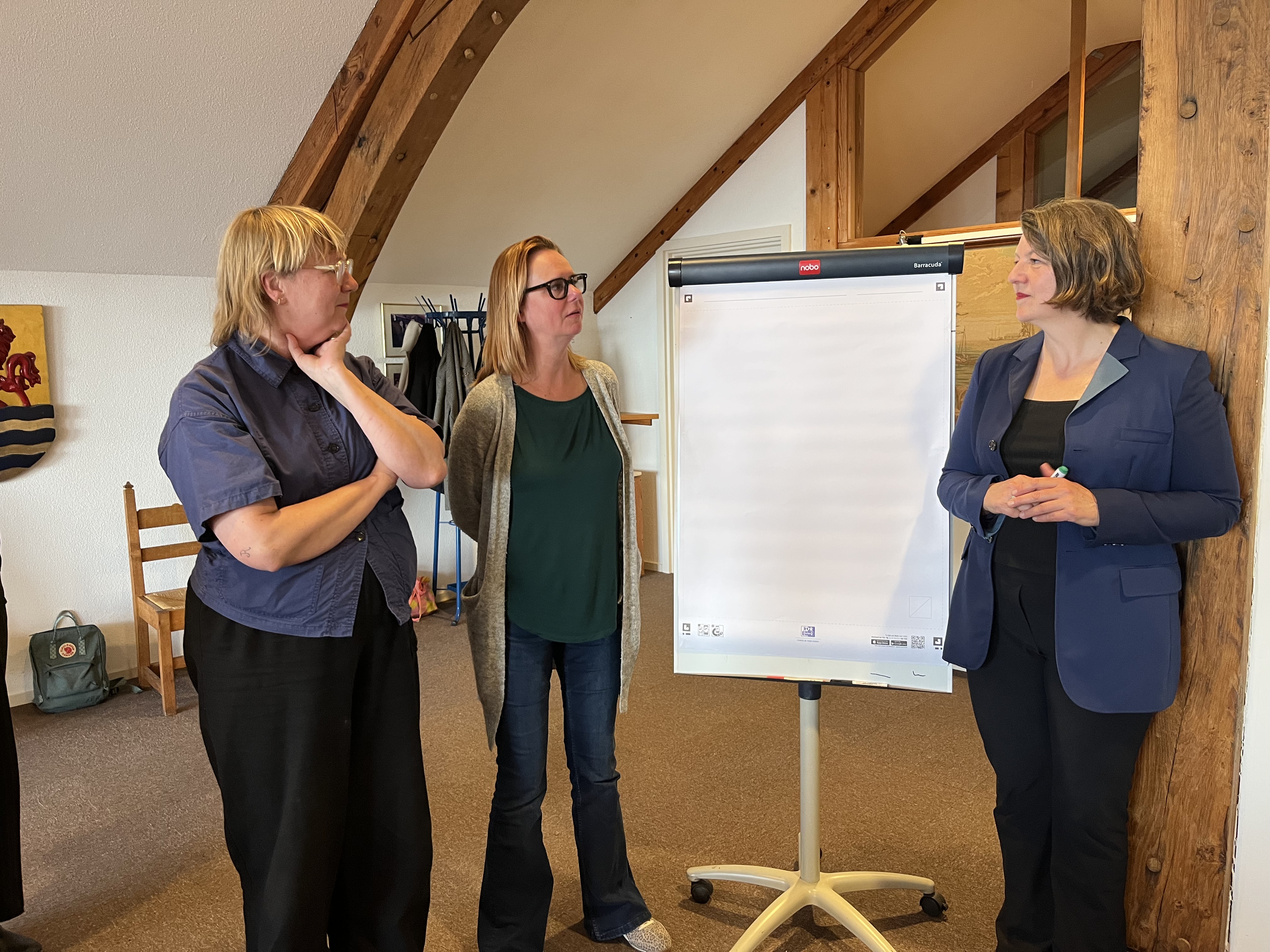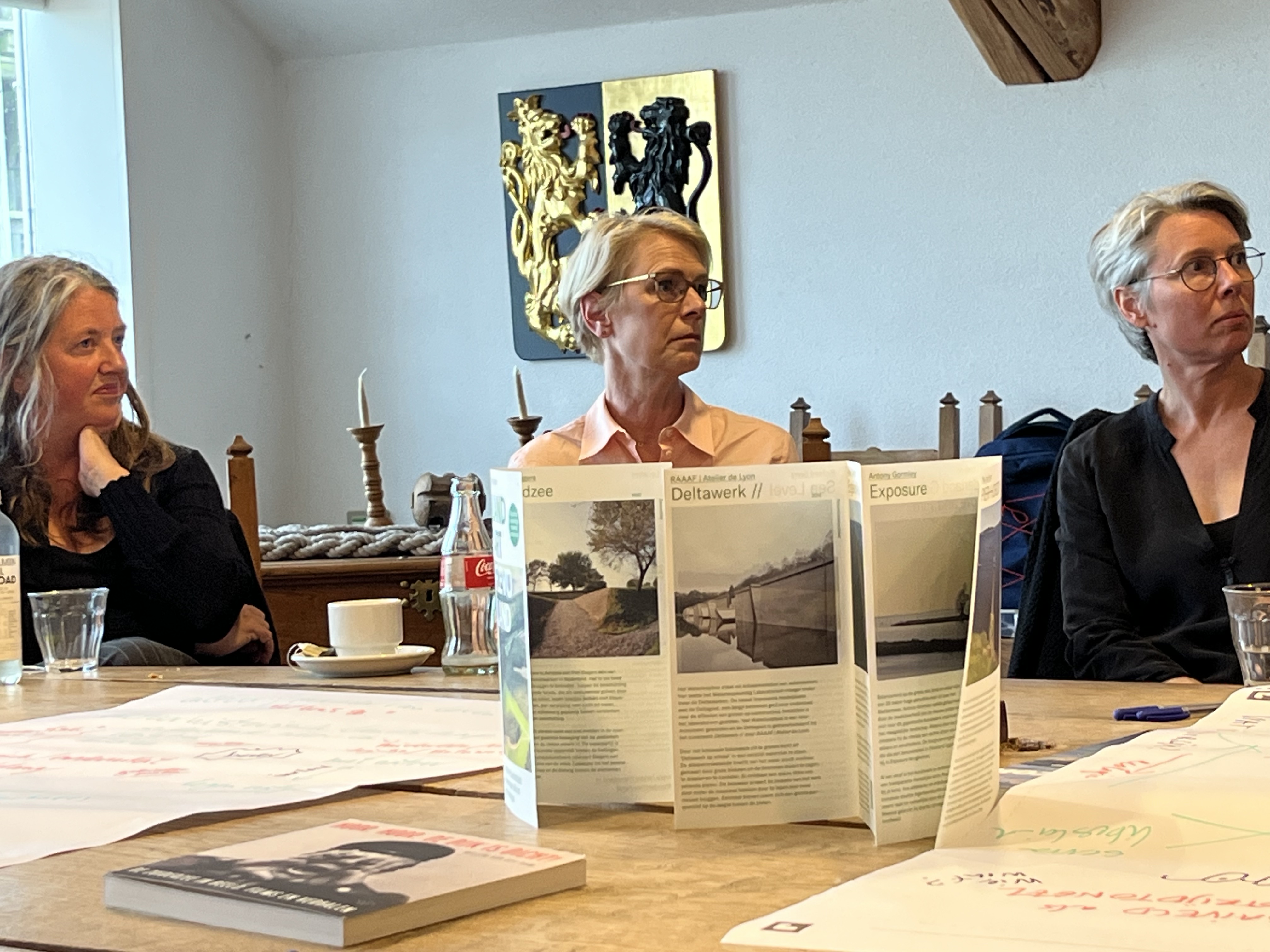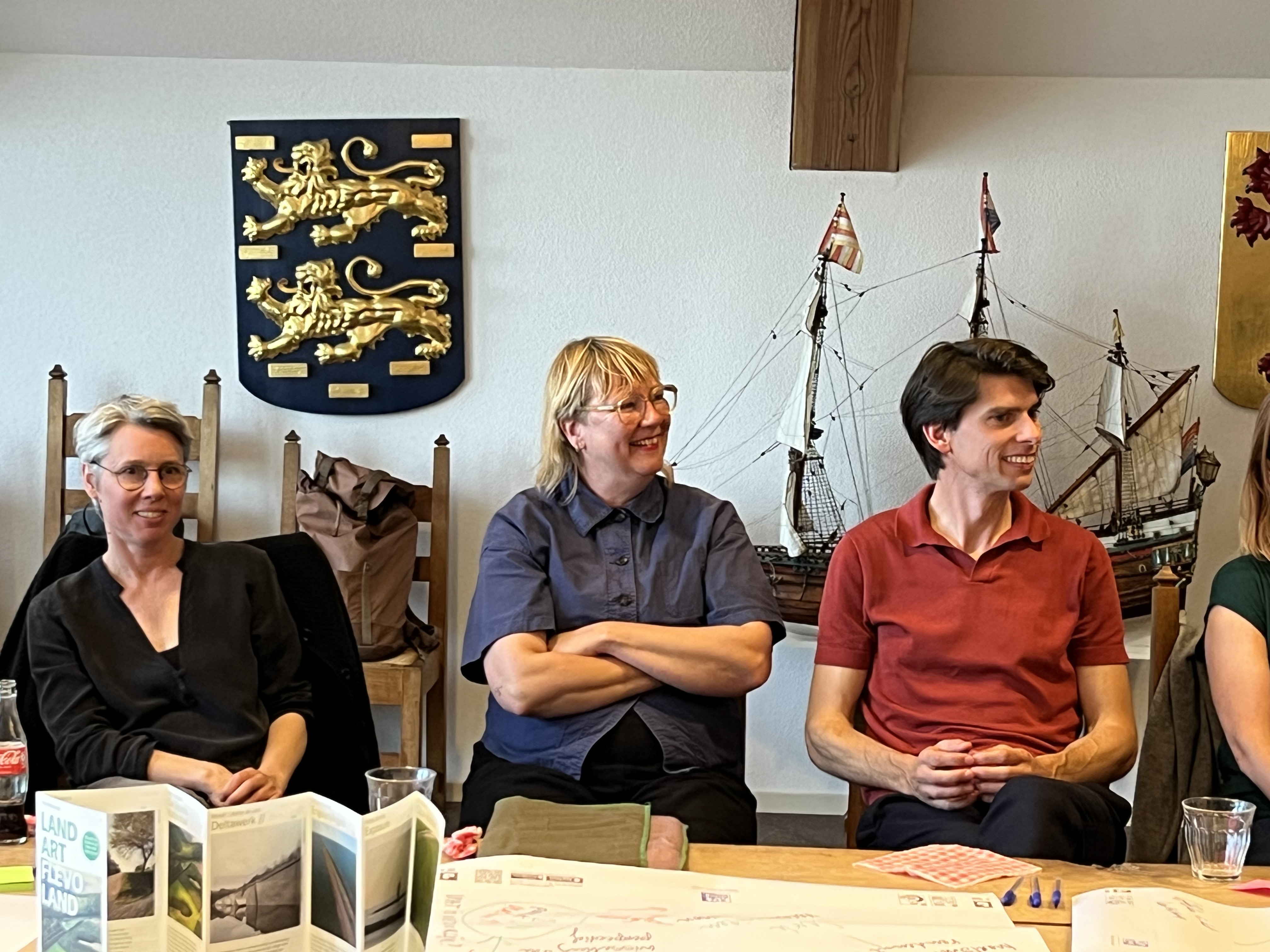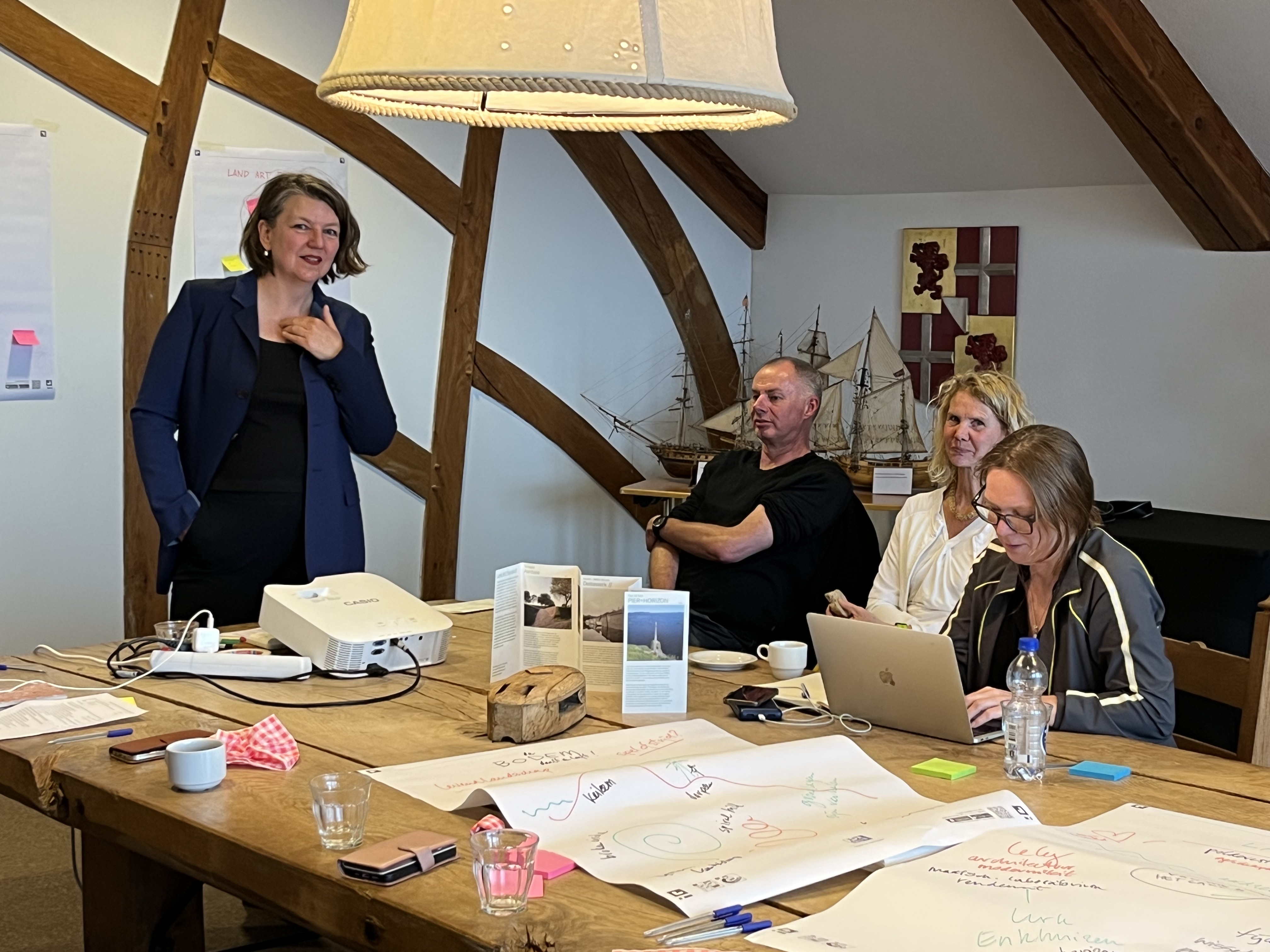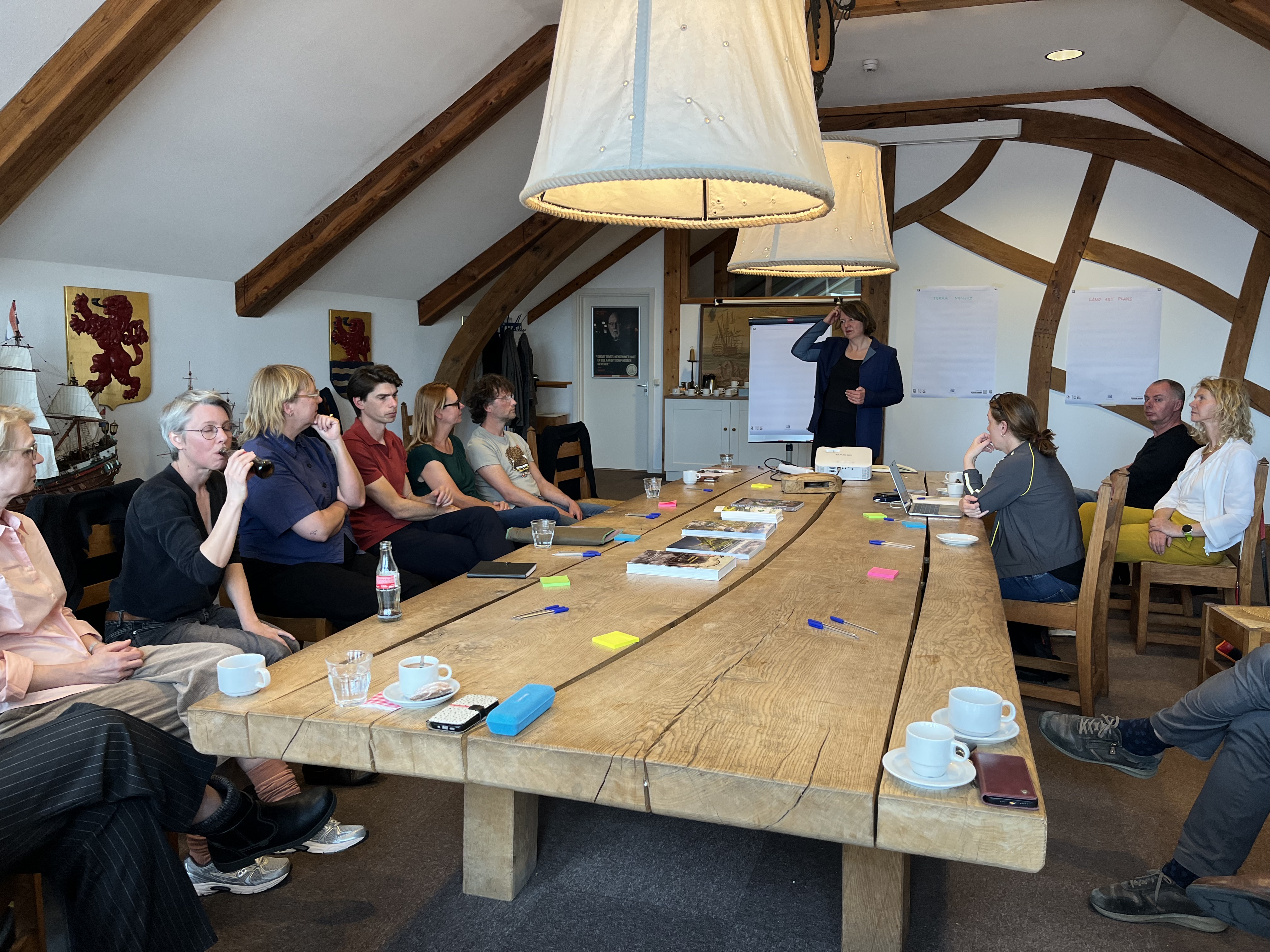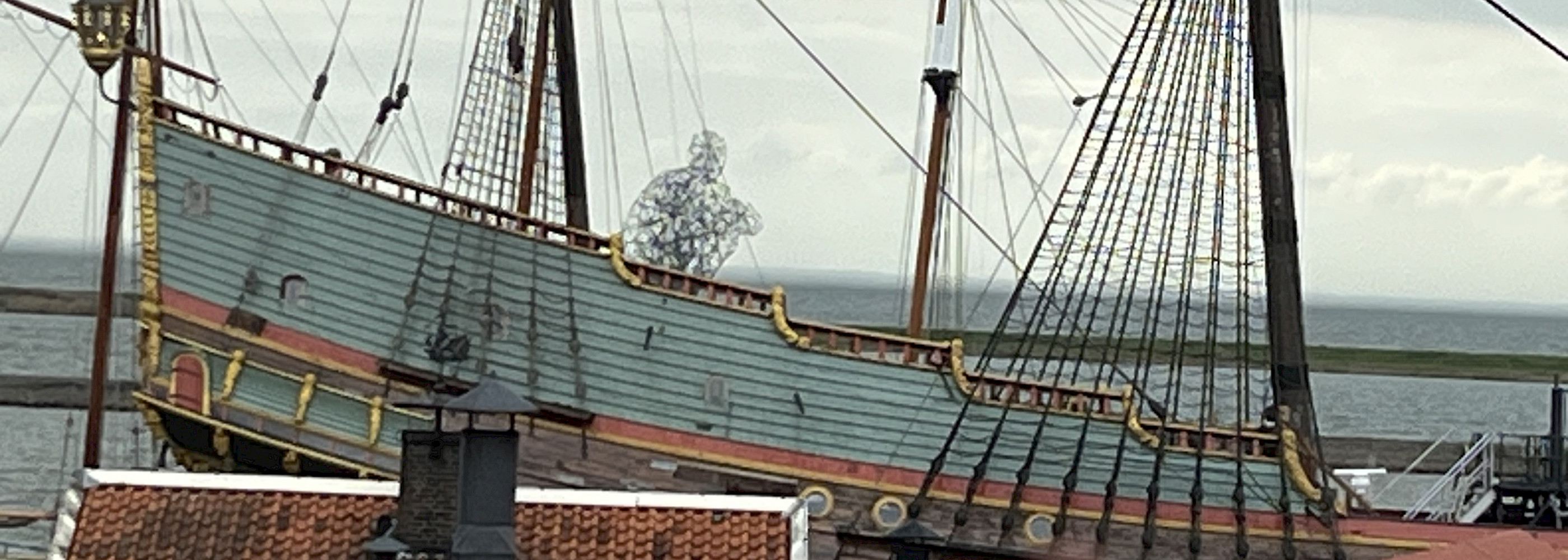
Time for a different story, report on Claiming Land
by Marjolein Sponselee
In the commander's room at Museum Batavialand, the chairs bearing the VOC (East India Company) logo have been firmly relegated to a corner. Not a single participant in the expert meeting Claiming Land in Flevoland chooses to sit on them. Our presence here is no coincidence: the history of the VOC and the Dutch colonial past remains entwined with the story of Flevoland. Not only through the maritime trade, but also through the very notion that land can be shaped to one’s will—that a small, powerful group can simply decide as much. Granted, the intention was quite different.
The American artists of the 1970s who pioneered land art were scarcely aware that staking out land for the sake of an artwork carried colonial undertones. Can one simply appropriate a piece of land? Many artists, after all, treated it primarily as abstract material—seldom engaging with the history of the place. Their focus lay more on the landscape’s formal qualities.
The first session of Claiming Land for Art, Claiming Land through Art, part of Land Art Lives (17 September 2024), explored these questions from an international perspective. This second gathering—an expert meeting at Museum Batavialand—builds on that initial session, this time with a focus on Flevoland.
Moderator Meta Knol outlines the path forward using the metaphor of a soil drill: a layered exploration through subsoil, surface, and society to uncover what defines Flevoland, and how these characteristics might resonate in relation to land art. The assembled experts contribute from their perspectives as artists, curators, (art) historians, geographers—and as Flevolanders. One of them positions herself as nature’s spokesperson. Together, they take a fresh look at the province, seeking a perspective for the future. The result is a lively exchange that touches on many topics, ranging from the physical landscape to questions of ownership and meaning. With a rich harvest, the soil drill resurfaces.
[text continues after photos]
Starting with a clean slate
In the beginning, there was nothing—and out of that nothing, engineers created Flevoland. The image of Flevoland as a blank canvas where anything was possible has proven remarkably persistent. But is it true?
That depends on whom you ask. The fishermen who once made their living on the Zuiderzee, and saw their entire way of life swept away, would likely say no. They were offered jobs in factories—sometimes with the well-meaning assumption that it would be better for them too. But factory work is a far cry from a life at sea, and with it, an entire culture vanished. That’s too romantic a view, says the social geographer. No one lived here. It was an inaccessible marshland.
And even that’s not entirely true, the historian replies. Neanderthals once lived here. Michelle—the second-oldest skeleton ever found in the Netherlands, dating back 7,000 years—was unearthed in this very area. And there are signs of human habitation going back 10,000 years. People lived here well into the Middle Ages.
In short, Flevoland was never a tabula rasa—there was already much more. So why does the image of a clean slate remain so persistent? The idea of social engineering plays a role here: the modernist belief that a government can design an ideal society—by creating new land, building new cities, and beginning afresh. Like playing God.
A new beginning carries the implicit promise that what comes next will be better than what came before. It reflects a belief in progress: better, more beautiful, more efficient. And part of that belief is rooted in the collective effort behind it—land reclamation offered the Netherlands more farmland, more space for housing, and fewer floods. The fact that things were lost in the process was either downplayed or considered a necessary sacrifice. The new society, after all, was meant to benefit everyone. But isn’t that, at its core, a colonial idea—to decide for others what is good for them? In such narratives, the voice of those in power always carries further.
The interests of the collective outweighed those of the individual—and those of humankind took precedence over nature. But views evolve. Former Chief Government Architect Eric Luiten once remarked that if we were to conduct an environmental impact assessment on the Afsluitdijk today, it would never be built. Its impact on nature was immense. Decades later, this gave rise to the construction of the Marker Wadden—a new nature reserve in the Markermeer aimed at boosting biodiversity. A noble plan, but the idea that society and nature can be shaped at will has its limits: water has already begun reclaiming parts of the artificial archipelago.
The idea of improvement through design extends beyond land and nature; it also concerns humanity itself—and reaches further back in history. Take, for instance, the Colonies of Benevolence, established in 1818 by Johannes van den Bosch as part of a plan to combat poverty through agricultural colonies. Drawing on his experience in the Dutch East Indies, Van den Bosch thought: why not apply the same model here? Poor people could be put to work on cheap land. They were given a house—but had to repay the cost through labor, a debt that often took years to clear. There was also a penal colony, and at times the colonies served as sites of re-education for people convicted of minor offences.
Striking is the layout of the Colonies of Benevolence—a design that, incidentally, was also used in overseas colonies. Everything was arranged in a rigid grid of long, straight lines, enabling oversight and reinforcing social control. The clarity of this layout also carries an aesthetic dimension: it evokes calm and a sense of space. The layout of Flevoland reflects the same principle—long, straight lines extending towards the horizon.
The soil is not stable
What lies beneath that efficiently designed landscape? What emerges when the soil drill is driven into the ground? The word soil suggests a stable foundation—but that, says the geographer, is misleading. Flevoland’s soil is anything but flat or still. It contains sloping layers, ancient creeks and gullies, and elevated natural levees. It was also once a tidal landscape, shaped over centuries by the slow rise of sea levels. In short, it is not a single thing. The soil holds traces of Ice Age moraines, but the region was once tropical too—even hippos once roamed here. Hundreds of shipwrecks lie buried beneath the surface, and near Zeewolde, the remains of a castle have been unearthed. In short: a great deal has happened here. Looking at the past, it becomes clear that Flevoland is far from an empty area—though much remains unknown. We were not there—yet obviously, things continued to happen, even in the absence of people.
The soil holds countless stories, many of which have barely been touched on in land art. In fact, in Flevoland, only Bob Gramsma’s work engages directly with the soil itself. The fact that land art projects have so far paid little attention to these stories says something about how we relate to Flevoland: through the lens of the white men who created it. The heroic narrative of the engineers prevails, while all other stories remain largely untold.
Ground level: nature or not
Flevoland: a wide, open view, with straight lines stretching out beneath a towering sky. Many land art works engage with that aesthetic, responding to the layout of the engineered landscape. Think of Daniel Libeskind, Piet Slegers, Richard Serra—or Anthony Gormley’s figure gazing out toward the horizon.
The notion of polder aesthetics is uttered. One has to love it—that space, that open view. But much depends on one’s perspective. It was designed with great care and attention, says one participant. Engineer Lely solved a real problem—this was a flood-prone area.
At the expense of the fishermen, counters another. It wasn’t just about land; it was also about people. Flevoland was a social laboratory. There was once a report suggesting that some residents of Urk should be relocated—space was needed for other purposes.
The psychological impact of such decisions has received little attention in Flevoland’s story so far. Much is said about economic consequences, but rarely about what it does to people when the horizon shifts. And the perspective changes with the speaker. A planner may be satisfied when wind turbines are neatly plotted in a sparsely populated corner of the province. But for those who live there, such a decision has an entirely different impact—one that is rarely heard.
At ground level, in the tightly packed Netherlands, there is always a tension—a quiet ‘battle’—between nature and the productive landscape. Farmers envision a different kind of landscape than nature lovers. But then—what is nature, really? It’s a matter of perspective, shaped by shifting perceptions. If you grow up in Almere, or in the countryside of any province, even the polder can feel like nature.
And what we mean by nature today is not what it meant fifty years ago. Humans are not outside or above nature—we are part of it. And when something is built, the impact on non-human life is even taken seriously.
At the same time, nature is not without agency; it asserts itself and follows its own path. The water is once again breaking up the Marker Wadden. And when a beaver is driven off, it simply builds a dam elsewhere—redirecting the course of a river. So nature, too, brings about change—but unlike humans, it doesn’t reflect on it, and it certainly doesn’t write reports about it (as far as we know).
The people
The final layer of information concerns human life. How do people live in Flevoland—how have they fared? Interest in that aspect often appears to cease on 28 September 1967, the day the first residents of Lelystad received the keys to their new homes. Pioneers entering a new world. But much more has happened in the fifty years since. A whole generation has since grown up here—two, in fact. For them, this so-called new world is simply home, no different from that of any other Dutch resident.
And yet, the much-used word pioneer still holds meaning for some. Those present who grew up in Flevoland recognize traces of that pioneering spirit. It made you resourceful, they observed: if you wanted something, you had to organize it yourself—there simply weren’t many facilities yet. Still, there was space to set things up yourself.
And yet, they too are weary of the term pioneer. Just like the word new, it reduces Flevoland to a single moment—the moment when the engineers created the land. But what happened next? And what came before?
For the artworks, there’s an opportunity to explore those stories—both in future commissions and in existing works. Daniel Libeskind’s work, for instance, is no longer just the artwork he once conceived. In its 28 years of existence, it has become a meeting point—part of the fabric of Almere, and of the lives of its residents. Perhaps the same could be true for other works, or an additional layer could be deliberately introduced: one that moves beyond land reclamation and the celebration of technical achievement. Down with the heroes. What’s needed is a plurality of voices—space for the human dimension, and for what was lost along the way. In short: the passage of time must be acknowledged.
The conclusion of the afternoon is clear: a different narrative is needed. Or rather—several. Among the 17 persons at the table, a wide range of perspectives surfaced. Despite their expertise, everyone present heard something they hadn’t known before. And then there are the things none of us know—topics that weren’t touched on today. The seafaring past and the VOC were left largely unaddressed, and more stories will undoubtedly emerge in a future conversation. What’s clear is that there is a rich breeding ground for the land art of the future—a goldmine for artists. The main takeaway from this afternoon: those other stories deserve space. The words new and pioneer can be set aside. There is so much more to tell.
Participants: Berthe Jongejan, Marcel Jansen, Truus Visser, Ronald Nijboer, Anja Novak, Jolle Roelofs, Neetje ten Westenend, Alice Smits, Remco van Diepen, Willem van der Ham, Vincent de Boer, Tessa Haan, Miriam Antonius, Fréderique Kreeftenberg, Martine van Kampen, Anne Reenders, Marjolein Sponselee (report) and Meta Knol (moderator).
